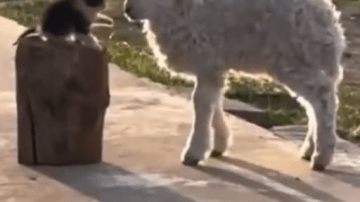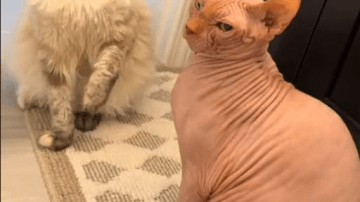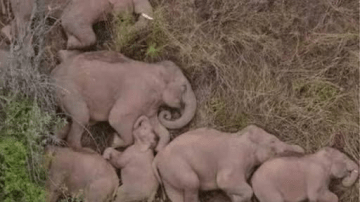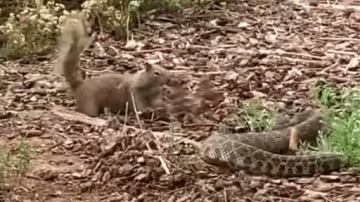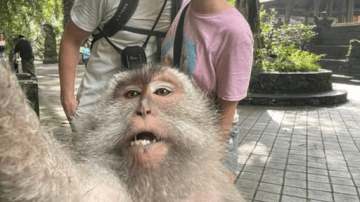When the phone rang, the voice on the other end was cracking with terror. A woman sobbed through her words as she described a dog lying on the edge of a riverbank. He was bound by a metal chain so tight that his body twisted around it, his eyes bloodshot from pain and fear. Trash drifted along the waterline. There were no people in sight. Only this battered soul struggling against the pull of the current and the choke of steel. In that moment, one cry for help set a miracle in motion.

The Riverbank Rescue
The team arrived to a scene that would sear itself into memory. The dog could not stand. He flopped and dragged himself through the dirt, legs limp and unresponsive. Every movement brought a whimper and a tremor. He was trying to live even as the world seemed determined to let him die. Hands moved quickly. The chain was unfastened. The small body loosened with a gasp. They lifted him free just as the tightening links threatened to crush his throat. Shock and rage mixed with relief. The team named him Pickles, a small name for a small dog whose will to live would prove enormous.
Pickles’ back bore a deep wound that looked like the mark of a heavy blow. His neck carried a raw ring where the chain had bitten into the skin. One eye was crimson with pooled blood. He panted with fever and pain as the car sped toward the hospital. Someone placed a cool cloth along his spine. Another stroked his head and whispered that he was safe. They promised him they would not stop until they understood what was wrong.
First Tests and First Hopes
At the clinic, the emergency room lights cast a clean glow over a bruised life. Pickles was stabilized. His temperature began to fall. He received medication to ease the pain and stop the convulsions that had shaken him on the riverbank. X rays were taken. Ultrasounds were performed. Blood was drawn to look for infection, anemia, and any silent disease that might be lurking.
Morning brought a fragile first hope. His temperature stayed down. The tremors did not return during the night. His eyes quieted from furious red toward normal color. He even ate soft food with a gentle eagerness that made the entire team smile. Yet the mystery remained. The X rays showed no fracture that could explain why his back legs would not move. There were no clear injuries to his neck either. Something was wrong, but it was hidden deeper than the films could reveal.

Searching Deeper for Answers
The neurologist recommended a CT scan. The images might show swelling or damage that X rays could not. While waiting for the appointment, bloodwork confirmed infection and anemia. Pickles’ body had been under siege for too long. The call came sooner than expected. His condition in the cervical region appeared to worsen, so the CT scan was moved up. Pickles was tucked onto the table. The machine hummed. The team waited.
The results were maddening. The scans did not explain the paralysis. They provided no clear reason that he could not use his hind legs. To make matters worse, he began to urinate blood and was diagnosed with cystitis. Hope wavered, but it never fell. The neurologist adjusted medications and ordered more tests. Pickles kept eating. He kept trying to lift his head. He kept looking for hands to hold him. The spark in his eyes said he would fight, so everyone around him fought harder.
The MRI That Mapped the Pain
If the CT could not answer the questions, an MRI might. This time, the picture was clearer. The images revealed spinal edema, swelling likely caused by violent trauma to the back. The diagnosis explained the agony that gripped his body and the limp that controlled his legs. The solution would not be simple. It would require time, medication, inflammation control, and a rehabilitation plan that stretched into months, not days.
Acupuncture began alongside physiotherapy. Gentle hands guided stiff limbs through small arcs of motion. Lasers warmed muscles that had forgotten their purpose. Each session was a quiet promise that the body could learn again. The cystitis continued to complicate recovery, but it was treated. Pickles was still afraid of men. He flinched when a deep voice filled the room, a living echo of the violence that had once cornered him near the river. His caregivers moved slowly, speaking softly. Trust takes as long as it takes. They gave him the time he needed.

Fighting Invisible Enemies
Even as his spirit lifted, Pickles battled new medical storms. Laboratory results showed a muscle infection that demanded stronger antibiotics. In heartbreaking turns, several standard medications failed. The bacteria resisted. The infection spread from the bladder into the kidneys. Pickles was hospitalized again. He developed painful pressure sores from lying down too long. The team added special mattresses to protect his skin and adjusted his position frequently to ease the ache.
The setbacks did not dull his light. Each morning he went outside for sunshine therapy and a breath of fresh air. He tilted his face to the warmth and closed his eyes as if to sip the bright new day. He played clumsily with his pillow, scattering the stuffing with puppyish glee. He barked for his food and knocked over a bowl like any normal young dog who is hungry and happy to be alive. Through it all, the staff reminded themselves that healing is not a straight line. A life that has been shattered rarely mends in one simple piece.
The Tests That Said We Still Do Not Know
A spinal tap was performed to check for infections affecting the nervous system. A muscle biopsy was taken to explore deeper causes of weakness. The results returned without the clarity everyone wanted. No easy answer. No single culprit to point to and cure. There was only the evidence of trauma and the proof of swelling and the puzzle of a nervous system that had endured more than a body should. The plan remained steady. Continue therapy. Manage pain. Support the organs that needed time. Protect the skin. Feed the spirit.
In the middle of all the uncertainty, one more challenge appeared. Ultrasound and blood tests suggested serious changes in the liver. A specialist adjusted his medications and diet to support recovery. With every new hurdle, Pickles answered with the same steady gaze and the same eager appetite. He ate the special food with delight. He learned the routine of treatments and trusted the hands that came to help him.
A Short Homecoming and Another Fight
There was a brief window when Pickles left the hospital and settled into a paid foster home set up for special needs dogs. The atmosphere was quieter. The stress of constant beeps and doors and voices relented. He continued physiotherapy and acupuncture. He soaked up cuddles and sunbathing in the grass. His progress was small but real. Then the infection flared again. Antibiotics failed again. He was readmitted.
This time the new antibiotic worked. The culture results guided the choice. At last the fevers dropped. The blood in his urine cleared. The kidney values improved. Small victories can feel like banners when you have learned how quickly ground can be lost. The team marked the day with extra treats and long strokes. Pickles wagged and pressed his head into every palm he could find.
A Brave Spirit in a Fragile Body
Pickles carried scars on his skin and deeper marks in his heart. He shied from certain footsteps. He watched the door a little too closely when a stranger entered the room. Yet he also sought affection with starry optimism. To meet him was to meet a paradox. He was a survivor who still trusted. He was a wounded dog who woke up every day ready to love. Around him, people learned what real courage looks like. It is not loud. It is consistent. It keeps showing up. It keeps wagging its tail.
Through weeks that stretched into months, he never missed a therapy session. His caretakers worked his legs through careful exercises. They used laser therapy to ease inflammation and acupuncture to encourage nerve response. The goals were realistic. These treatments might not make him walk. They would, however, help him stay strong, stave off pain, and claim the highest quality of life possible.

The Day Wheels Became Wings
The morning the veterinarian signed off on mobility assistance, the room felt different. It carried the electricity of a milestone earned one tiny step at a time. Pickles had been cleared to use a wheelchair. The harness slid into place. The small frame was secured. Someone held a hand beneath his chest while the wheels settled behind him. There was a pause. Then there was motion.
He rolled forward once and then again. His tail beat a bright rhythm. He learned how to pivot, how to push, how to glide. The courtyard that had once been a short stretch of grass opened into a runway. Pickles flew. He chased sunlight across the pavement and veered with a joyful bark. People laughed and cried in equal measure. In those wheels, he did not look broken. He looked free.
Lessons from a Survivor Named Pickles
Pickles’ story is a map of what compassion can do. A stranger heard a cry and refused to look away. Rescuers raced to a riverbank and unfastened a life that had been tied to despair. Veterinarians and specialists searched through layers of mystery and pain until they found a way forward. Therapists and fosters built a daily rhythm of care that honored both body and spirit. Donors and well wishers added their love from a distance. Together they created a safety net wide enough to catch a dog who had fallen too far.
There are truths in his journey that reach beyond a single rescue. Healing does not always give us the answers we want, but it gives us the progress we need. Justice launched an investigation and voices rose to say that what happened to Pickles was unacceptable for any living being. While the past cannot be rewritten, the future can be fiercely protected. Every report filed. Every treatment paid for. Every hour spent stroking a head while a fever breaks. This is what it looks like when a community decides that pain will not have the final word.
Hope You Can See and Touch
Today, Pickles is a happy dog in every way that counts. He gobbles his meals and nudges his pillow into clownish shapes. He soaks up morning sun and offers kisses to the people who wheel him outside. He is still working through fear. He is still living with paralysis. He is still receiving treatment for chronic cystitis and remains on a careful plan for his liver. Yet none of these limits have managed to crush his joy. He embodies the truth that a full life is not defined by the ability to run but by the ability to love and be loved.
When he glides across the grass in his wheelchair, he is not a victim. He is a teacher. He tells us that resilience is built from small choices repeated daily. He tells us that kindness is a practice, not a single act. He tells us that giving up is easy and that holding on is sacred. Most of all, he shows us that a cry for help can be the first chapter of a beautiful story if someone chooses to answer it.
Pickles answered it with courage. The rescuers answered it with action. The world can answer it as well, with every adoption, every donation, and every shared message that says cruelty will not be ignored. The little dog at the riverbank now moves forward on two wheels and a thousand prayers, a living reminder that when love refuses to quit, hope finds a way.
Pickles, you are proof that a broken beginning can lead to a brave and shining life.

